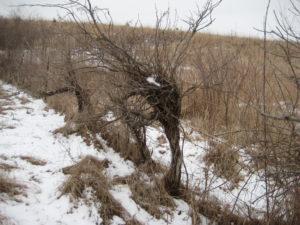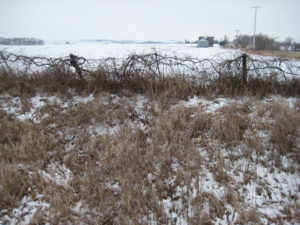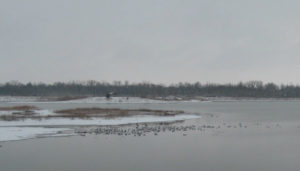Fueling Wildlife and Us
Plants are the master chemists, and the bottom line for all terrestrial ecosystems is their ability to convert water and carbon dioxide into sugar, via photosynthesis. Sap is dilute sugar water, which gets pumped from the leaves to the rest of the plants’ cells, where they break the sugar’s bonds to release the solar energy needed to grow and reproduce. Animals eat the plants to capture this energy for themselves.
There are many kinds of sugars, but most involve hydrogen, oxygen, and carbon bonded into simple chains. Where compact storage of energy is important to a plant, especially in seeds and rhizomes, they have evolved the ability to cross-link the sugar chains, with more energy input, into a new product we often label starch.
But structurally, neither sugar nor starch are very strong or durable materials, and so for structural strength, plants cross-link starch further into a dense three-dimensional grid, producing cellulose. The cellulose is formed up into fibers, tightly packed, and glued together with lignin to create the basic structures of plants: the leaves, stalks, trunks, and roots.

Poison ivy on a fence post, transforming itself into a bush by investing in more cellulose support.

Wild grape climbing a fence, has no intention of investing more energy in cellulose support, and instead lays down along the top wire.
Building these durable cellulosic structures, some of which can last a thousand years, requires even more inputs of solar energy, so some species have evolved a short cut by becoming vines and obtaining part of their support from other nearby species. Some, like wild grape and Virginia creeper, are committed to the vining lifestyle, and if lacking nearby support will run along the land surface as a groundcover. But their fruits are attractive to birds, which often perch on branches or fences, so much of their processed seed winds up conveniently beneath some type of support. Other species are transformers. Poison ivy will climb a fence post or a snag as a vine, and when it reaches the top will switch over to thickening the vine into a trunk with branches, and transform itself into a bush. When the snag or wooden post rots away, it will become entirely self-supporting if necessary.
The animal world gets its energy to grow and reproduce by breaking the plant bonds and releasing the solar energy, which leaves had originally captured. We humans can only burn the sugar called glucose in our cells, but we can efficiently convert many other sugars like maltose, dextrose, and fructose into glucose.
We do not do so well with the starches because the cross-linking is more difficult to break apart. But high temperatures speed up the process and we have learned to boil, steam, or fry potatoes and rice, which makes them much more digestible. In baking bread, we first employ decomposers called yeast, which feed on the sugar and whose powerful enzymes start breaking down the wheat starch before the high temperatures of baking continue the process. Brewing beer is a longer sequence of processes, including malting, which break down the starches of seeds while preserving the high-energy alcohol byproduct rather than baking it off.
Cellulose and lignin defeat us metabolically, and we get almost no nutritional value from eating woody stuff. But of course we have learned to burn it to create the higher temperatures needed to modify the starches.
Other animals solve their energy needs in other ways, and you can determine where they are in the metabolic program by the relative length of their guts, which do the processing. The true carnivores, for example all of the various cats, have short guts because the meat they eat does not contain the more difficult cross-linked hydrocarbons of plant starches, because their prey has already processed it. So if you come across the remains of a rabbit eaten by a hawk, the stomach is often still there because the hawk cannot digest the grass or twigs within. The omnivores, including us, the bears, and the raccoons, have longer guts, both to obtain longer processing times and to make room for the more elaborate colonies of microbes, which help to break down the cross-linking into more digestible simple sugars.
The grazers and browsers have their own systems for dealing with their rather cellulosic diet. Geese and caterpillars simply eat large quantities of leaves, quickly adsorb the most soluble nutrients, and pass the rest through undigested. If you walk quietly at night through a forest heavily infested with gypsy moth caterpillars, you can hear the gentle patter of fecal rain.
The ruminants, like deer and sheep, have evolved an extra holding chamber in their gut (the rumen), where their very specialized microbial flora gets the opportunity to really work over the plant tissues and even break down some of the cellulose. Termites are cellulose specialists and get most of their energy from their very specialized microbial partners, who focus on taking apart the cross-links.

Terry Trueblood Lake, a former sand pit, is now a useful stopover for migratory waterfowl.
There is of course much more to the nutrition story, but sometimes, I find it worthwhile to strip Nature’s complexity down to a few basics. And this reveals that we are just another animal, which must play the game of life by the same rules as the others. By one calculation (I can’t locate the reference), about 45% of the earth’s total photosynthetic output of nutritional energy, from land and seas, gets funneled into supporting the seven billion of us, which today leaves little for all the others. This makes the thoughtful and deliberate management of conservation lands for all the other species so important. Even reclaimed strip mines, former brownfields, oil spill cleanup sites, closed landfills, mini parks and little backyards become important habitat if managed well.


